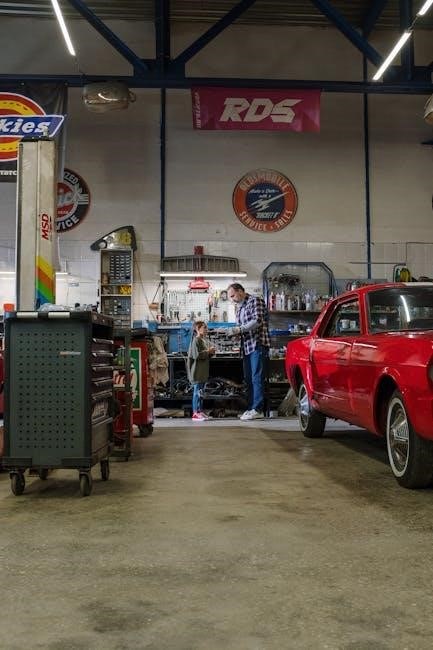Safety Precautions and Basic Instructions
Always read the manual before first use. Ensure the lid is tightly closed and avoid touching hot surfaces. Keep children supervised and never operate unattended. Regularly inspect valves and gaskets for blockages or damage. Avoid using abrasive cleaners to prevent scratching. Ensure all parts are dry before assembly. Follow recommended cooking times and pressures to prevent overcooking. Keep hands and face away from steam vents during operation. Never force the lid open; allow pressure to release naturally. Store the cooker in a cool, dry place when not in use. Always use oven mitts when handling hot components. Follow these guidelines to ensure safe and effective pressure cooking.
1.1 Essential Safety Tips for First-Time Users
For first-time users, ensure the pressure cooker is placed on a stable, heat-resistant surface. Always handle hot components with oven mitts and avoid overfilling the cooker. Keep children away during operation and never leave the cooker unattended. Before use, inspect the sealing ring and valves for damage. Ensure all parts are dry to prevent steam burns. Avoid opening the lid until pressure is fully released. Familiarize yourself with the pressure release valve to avoid accidental burns. Never use abrasive cleaners or sharp objects that could damage the cooker. Always follow the recommended water levels and cooking times to ensure safe operation.
1.2 Understanding Pressure Cooker Valves and Their Functions
The pressure cooker features essential valves that regulate cooking pressure and ensure safety. The pressure regulator valve controls the pressure level during cooking, while the steam release valve allows manual pressure release. The float valve indicates when pressure is built up or released. Regularly check these valves for blockages or wear. Clean them gently to maintain proper function and prevent accidents. Understanding their roles ensures safe and efficient cooking.
1.3 Common Mistakes to Avoid When Operating a Pressure Cooker
Avoid overfilling the cooker, as this can lead to clogged valves and unsafe pressure buildup. Never force-open the lid while pressure is still present. Ensure the sealing ring is properly aligned and free of damage. Avoid sudden pressure release, as it can cause scalding steam. Do not neglect regular cleaning of valves and gaskets, as this can impair function. Always follow recommended cooking times to prevent overcooking. These precautions ensure safe and effective pressure cooking.

Parts and Components of a Pressure Cooker
A pressure cooker consists of a sturdy pot, locking lid, sealing ring, pressure valve, and regulator. These components work together to create and control pressure safely.
2;1 Overview of Key Components (Lid, Sealing Ring, Pressure Valve, etc.)
The pressure cooker includes essential components like the lid, sealing ring, pressure valve, and regulator. The lid locks securely to contain pressure, while the sealing ring ensures an airtight seal. The pressure valve regulates steam release, and the regulator controls pressure levels. Additional parts may include a floating valve, inner pot, and control panel. These components work together to ensure safe and efficient cooking. Proper assembly and maintenance are crucial for optimal performance and safety.
2.2 Functions of Each Part and Their Importance
The lid ensures a secure seal, preventing steam escape and maintaining pressure. The sealing ring creates an airtight environment, essential for pressure buildup. The pressure valve regulates steam release, controlling cooking pressure. The regulator adjusts pressure levels, ensuring safe operation. The inner pot holds ingredients, while the control panel manages settings. Each part plays a vital role in safety, efficiency, and cooking performance, requiring proper care to maintain functionality and prevent malfunctions during use. Regular inspection is recommended for optimal results.

Preparation and Initial Setup
Unpack and wash all parts with mild soap. Assemble the cooker by attaching the valves and sealing ring. Inspect for damage or blockages. Pre-use checks ensure safety and proper function. Clean the inner pot and lid before first use. Familiarize yourself with controls and settings for smooth operation. Ensure all components are securely locked in place before cooking begins. Proper setup ensures efficient and safe pressure cooking experiences.
3.1 Unpacking and Assembling the Pressure Cooker
Begin by carefully unpacking the pressure cooker and its accessories. Wash all parts, including the inner pot, lid, and gasket, with mild soap and dry thoroughly. Inspect for any damage or blockages. Attach the sealing ring to the lid, ensuring it fits securely. Install the pressure valve and float valve according to the manual. Align the lid with the cooker base and lock it into place. Double-check all connections before first use to ensure proper function and safety.
3.2 Pre-Use Checks and Maintenance Tips
Before each use, inspect the sealing ring, pressure valve, and float valve for damage or blockages. Ensure all parts are clean and dry. Lubricate the sealing ring occasionally for a tight fit. After cooking, wash the inner pot, lid, and accessories with mild soap. Avoid abrasive cleaners to prevent damage. Regularly check for wear on the gasket and valve. Store the cooker in a dry place to prevent rust. Perform these checks to maintain performance and longevity.

Cooking Modes and Settings
Explore manual mode for custom time and pressure control. Utilize preset programs for soups, rice, and meats. Adjust settings for precise cooking, ensuring optimal results for any dish.
4.1 Manual Mode: Adjusting Time and Pressure
Manual mode allows precise control over cooking time and pressure. Use the +/- buttons to adjust time between 5-120 minutes. Select high or low pressure based on the recipe. Ensure the lid is sealed properly before starting. The cooker will automatically build pressure and begin the countdown. For delicate foods, low pressure is recommended. Always refer to cooking guidelines for specific settings.
4.2 Preset Programs for Common Dishes
Preset programs simplify cooking for popular dishes like soup, stew, rice, and meat. Use the designated buttons for quick settings. The cooker automatically adjusts time and pressure for optimal results. For example, the “Meat/Stew” button sets high pressure for 30-45 minutes, while “Rice” uses low pressure for 10-15 minutes. Refer to the manual for specific preset times and pressure levels. These programs ensure consistent cooking results with minimal effort.
4.3 Advanced Features (Delay Start, Timer, etc.)
Advanced features like Delay Start allow you to schedule cooking up to 24 hours in advance. The Timer function lets you set specific cooking durations. Use the Keep Warm mode to maintain food temperature for serving. Some models offer Saute and Slow Cook functions for versatile cooking. These features enhance convenience, enabling you to prepare meals in advance and customize cooking processes according to your schedule and preferences for optimal results.
Care and Maintenance
Regularly clean the lid, gasket, and pot with mild soap. Avoid abrasive cleaners. Dry thoroughly after washing to prevent rust. Store in a dry place to maintain functionality and longevity.
5.1 Cleaning the Pressure Cooker After Use
After each use, wash the inner pot, lid, and seal with warm soapy water. Use a soft sponge to avoid scratching. For tough stains, soak in warm water. Dry all parts thoroughly. Wipe the exterior with a damp cloth. Regular cleaning prevents food residue buildup and ensures optimal performance. Always check the gasket for food particles and clean as needed. Proper maintenance extends the lifespan of your pressure cooker.
5.2 Storage and Long-Term Maintenance Tips
Store the pressure cooker in a dry, cool place, away from direct sunlight. Ensure all parts are completely dry before storage to prevent rust. Avoid stacking heavy objects on the cooker. Clean and inspect the gasket and valves regularly. Use a soft cloth to wipe the exterior. For long-term storage, detach and store the lid separately to prevent moisture buildup. Regularly check for wear and tear on seals and handles. Proper storage ensures longevity and optimal performance.
Troubleshooting Common Issues
Check for blockages in valves or steam vents. Inspect seals for wear or damage. Ensure the lid is properly aligned and closed. Refer to error codes in the manual for specific solutions. Addressing these issues promptly ensures safe and efficient pressure cooking.
6.1 Identifying and Solving Leaks or Pressure Problems
Leaks or pressure issues often arise from worn gaskets, misaligned lids, or clogged vents. Inspect the sealing ring for damage or wear. Ensure the lid is properly locked and aligned. Clean the steam vent and valve regularly to prevent blockages. If leaks persist, replace the gasket or check for tightness. Addressing these issues ensures proper pressure maintenance and safe cooking. Always refer to the manual for specific guidance.
6.2 Error Codes and How to Resolve Them
Common error codes like E1, E2, or E3 indicate issues such as lid alignment problems, temperature sensor malfunctions, or pressure imbalances. For E1, ensure the lid is properly aligned and closed. For E2, check and adjust temperature settings. For E3, clean the sensor or restart the cooker. Refer to the manual for specific error code meanings. Resetting the unit or consulting troubleshooting guides often resolves these issues effectively.

Recipes and Cooking Guidelines
Explore versatile cooking options for soups, grains, meats, and vegetables. Adjust liquid ratios and seasonings for optimal flavor. Use preset programs for rice, porridge, or yogurt. Convert traditional recipes by reducing cooking time and liquid. Achieve tender results with meats and legumes. Experiment with global cuisines for diverse meal ideas. Ensure consistent outcomes by following time and pressure guidelines.
7.1 Basic Recipes for Beginners
Start with simple recipes like white rice, boiled eggs, or chicken breast. Add 1-2 cups of liquid for rice and 1 cup for proteins. Cook rice for 4-6 minutes, eggs for 5-7 minutes, and chicken for 8-10 minutes. Season lightly and let pressure release naturally. Try vegetable soups by sautéing onions, garlic, and veggies, then cooking for 5-8 minutes. Experiment with beans or lentils, ensuring proper soaking times. These recipes build confidence and familiarize you with pressure cooking basics.
7.2 Converting Traditional Recipes for Pressure Cooking
To adapt traditional recipes, reduce liquid by 70% and shorten cooking times significantly. Adjust seasonings, as flavors intensify under pressure. For soups, use half the broth and add more later if needed. For stews or roasts, brown meat first using the sauté function, then cook for 20-30 minutes. Rice and grains require 1:1 liquid ratio, cooking in 4-6 minutes. Always follow safety guidelines and manufacturer instructions for best results.
Additional Resources
Visit the official website for downloadable manuals, troubleshooting guides, and recipe booklets. Access FAQs, user forums, and customer support for assistance. Download the full manual or contact support for further inquiries at official website.
8.1 Downloading the Full User Manual
To access the complete user manual, visit the official website of your pressure cooker’s manufacturer. Models like Instant Pot DUO EVO PLUS and Cosori Pressure Cooker CMC-CO601 offer downloadable PDF versions. Navigate to the support section, enter your model number, and follow the prompts to download. Ensure you select the correct model for accurate instructions. For assistance, refer to the link provided on the manufacturer’s site or contact their customer support team. Download here for detailed guidance.
8.2 Accessing Official Support and FAQ Sections
Visit the manufacturer’s official website to access support and FAQs. For models like Instant Pot or Cosori, navigate to the support section, enter your model number, and browse resources. FAQs cover common issues, troubleshooting, and maintenance. Use the search bar for specific queries or explore video tutorials for visual guidance. For direct assistance, use the live chat or contact customer support via email or phone, available on the official website. Visit support page for help.
